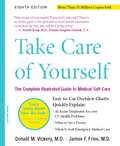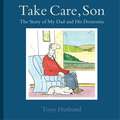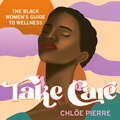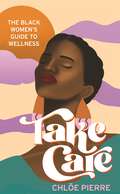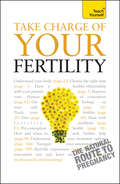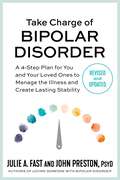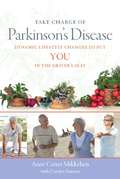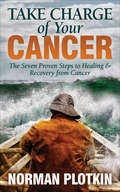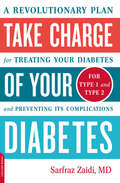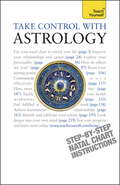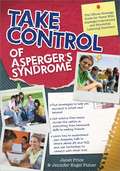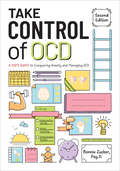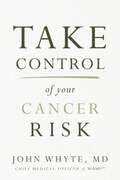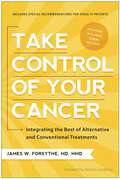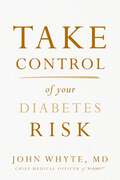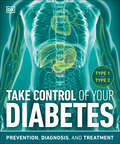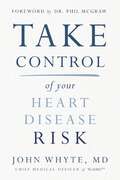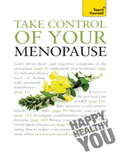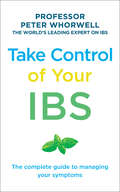- Table View
- List View
Take Care of Yourself: The Complete Illustrated Guide To Medical Self-Care (8th edition)
by James F. Fries Donald M. VickeryTake Care of Yourselfis the world's best-selling health guide, and the only one that has been found to help reduce visits to the doctor and save money. Covering nearly 200 health-care problems and symptoms, it is easy to use, even in a crisis. Readers can locate their symptoms in the easily navigable guide and find a complete explanation of likely causes and possible home remedies. Diagrams show how to recognize problems, and, in many cases, treat them quickly, and the decision charts advise when exactly it's time to see a doctor. This comprehensive guide also covers emergencies, health problem prevention, the 20 things everyone should keep in a home pharmacy, and how to work best with a doctor. Revised and updated, it remains the most comprehensive and dependable self-care guide, and is essential for every home.
Take Care, Son: The Story of My Dad and his Dementia
by Tony HusbandHi Dad . . . can we have a chat about your dementia . . . Can you remember how it started?When Ron Husband started to forget things - dates, names, appointments . . . daft things, important things - it took a while to realise that this was 'a different form of forgetting'. But it was just the first sign of the illness that gradually took him away from the family he loved.This is the touching, illustrated story of Tony's father and how dementia slowly took him away from his family. The title is a reference to his last words to his son - on a day when Tony had spent the day in the care home with no sign of recognition. The book is framed as a chat between Tony and his dad, who fades away through the last few pages of the book."... rather wonderful cartoon strips ... chronicling his father's dementia with loving charm and wit." Stephen Fry, Twitter
Take Care, Son: The Story of My Dad and his Dementia
by Tony HusbandHi Dad . . . can we have a chat about your dementia . . . Can you remember how it started?When Ron Husband started to forget things - dates, names, appointments . . . daft things, important things - it took a while to realise that this was 'a different form of forgetting'. But it was just the first sign of the illness that gradually took him away from the family he loved.This is the touching, illustrated story of Tony's father and how dementia slowly took him away from his family. The title is a reference to his last words to his son - on a day when Tony had spent the day in the care home with no sign of recognition. The book is framed as a chat between Tony and his dad, who fades away through the last few pages of the book."... rather wonderful cartoon strips ... chronicling his father's dementia with loving charm and wit." Stephen Fry, Twitter
Take Care: The Black Women's Guide to Wellness
by Chloe PierreJoin the wellness revolution by Black women, for Black women.Take Care prioritises Black women and their experiences and encourages them to take care of themselves in order to bring their best self into the world. A space for Black women to cultivate their joy is truly a necessity at a time when Black lives are at the forefront of discussions online and in the media, and Take Care is the audiobook to ensure that.Chloe Pierre, founder of thy.self, the brand making self-care inclusive, wants to inspire Black women to take time to care for themselves. In this audiobook she consults experts to create an inspiring and practical guide that offers ways to help you:- Be your authentic self - Embrace your beauty and feel body positive- Deal with grief, loss and mental health issues- Create a supportive and uplifting community- Practice self-love every dayTake Care is an audiobook of warmth, happiness and light, and will help you to refocus and put yourself first.(P) 2023 Headline Publishing Group Ltd
Take Care: The Black Women's Guide to Wellness
by Chloe PierreJoin the wellness revolution by Black women, for Black women.Take Care prioritises Black women and their experiences and encourages them to take care of themselves in order to bring their best self into the world. A space for Black women to cultivate their joy is truly a necessity at a time when Black lives are at the forefront of discussions online and in the media, and Take Care is the book to ensure that.Chloe Pierre, founder of thy.self, the brand making self-care inclusive, wants to inspire Black women to take time to care for themselves. In this book she consults experts to create an inspiring and practical guide that offers ways to help you:- Be your authentic self - Embrace your beauty and feel body positive- Deal with grief, loss and mental health issues- Create a supportive and uplifting community- Practice self-love every dayTake Care is a book of warmth, happiness and light, and will help you to refocus and put yourself first.
Take Care: The Black Women's Guide to Wellness
by Chloe PierreJoin the wellness revolution by Black women, for Black women.Take Care prioritises Black women and their experiences and encourages them to take care of themselves in order to bring their best self into the world. A space for Black women to cultivate their joy is truly a necessity at a time when Black lives are at the forefront of discussions online and in the media, and Take Care is the book to ensure that.Chloe Pierre, founder of thy.self, the brand making self-care inclusive, wants to inspire Black women to take time to care for themselves. In this book she consults experts to create an inspiring and practical guide that offers ways to help you:- Be your authentic self - Embrace your beauty and feel body positive- Deal with grief, loss and mental health issues- Create a supportive and uplifting community- Practice self-love every dayTake Care is a book of warmth, happiness and light, and will help you to refocus and put yourself first.
Take Charge Of Your Fertility: Teach Yourself
by Heather WelfordTake Charge of Your Fertility explains everything the prospective parent may need to know as they face the physical, emotional and practical challenges of trying for a baby. It covers health issues in full, from basic biology and an explanation of fertility and cycles to outlining what supplements are useful and what aren't, and how you can maximise your chances by following a healthy diet and cutting alcohol or nicotine intake. There are plenty of resources and guidelines for parents facing difficulties, including a guide to the medical options, and advice on how to seek further help. It will help couples to deal with the emotional issues faced when trying for a baby, and will also give practical information on who you should tell and who you must tell, and when. With coverage of all aspects of very early pregnancy, from do-it-yourself tests to the very first scan, it will be a useful resource which will help all prospective parents, whether looking to start or to expand their family.NOT GOT MUCH TIME?One, five and ten-minute introductions to key principles to get you started.AUTHOR INSIGHTSLots of instant help with common problems and quick tips for success, based on the author's many years of experience.TEST YOURSELFTests in the book and online to keep track of your progress.EXTEND YOUR KNOWLEDGEExtra online articles at www.teachyourself.com to give you a richer understanding of your fertility.FIVE THINGS TO REMEMBERQuick refreshers to help you remember the key facts.TRY THISInnovative exercises illustrate what you've learnt and how to use it.
Take Charge Of Your Fertility: Teach Yourself (Teach Yourself General)
by Heather WelfordTake Charge of Your Fertility explains everything the prospective parent may need to know as they face the physical, emotional and practical challenges of trying for a baby. It covers health issues in full, from basic biology and an explanation of fertility and cycles to outlining what supplements are useful and what aren't, and how you can maximise your chances by following a healthy diet and cutting alcohol or nicotine intake. There are plenty of resources and guidelines for parents facing difficulties, including a guide to the medical options, and advice on how to seek further help. It will help couples to deal with the emotional issues faced when trying for a baby, and will also give practical information on who you should tell and who you must tell, and when. With coverage of all aspects of very early pregnancy, from do-it-yourself tests to the very first scan, it will be a useful resource which will help all prospective parents, whether looking to start or to expand their family.NOT GOT MUCH TIME?One, five and ten-minute introductions to key principles to get you started.AUTHOR INSIGHTSLots of instant help with common problems and quick tips for success, based on the author's many years of experience.TEST YOURSELFTests in the book and online to keep track of your progress.EXTEND YOUR KNOWLEDGEExtra online articles at www.teachyourself.com to give you a richer understanding of your fertility.FIVE THINGS TO REMEMBERQuick refreshers to help you remember the key facts.TRY THISInnovative exercises illustrate what you've learnt and how to use it.
Take Charge of Bipolar Disorder: A 4-Step Plan for You and Your Loved Ones to Manage the Illness and Create Lasting Stability
by John Preston Julie A. FastRevised and updated, Take Charge of Bipolar Disorder is a groundbreaking, comprehensive program to help those with bipolar disorder—and those who care about them—gain permanent control over their lives. Most people diagnosed with bipolar disorder are sent home with the name of a doctor and multiple prescriptions. However, few people with bipolar disorder are able to find long-term stability with medications alone. Bipolar disorder researcher and expert Julie A. Fast, who was diagnosed with the illness at age thirty-one, and specialist John Preston, PsyD, offer the pioneering Take Charge program used around the world to help readers promote stability, reduce mood swings, increase work ability, decrease health care costs, and improve relationships. The book guides those with bipolar disorder and their loved ones toward a comprehensive personal treatment plan by incorporating: Medications and bipolar-safe supplements Lifestyle changes that help manage bipolar symptoms naturally Behavior modifications that reduce and prevent symptoms Guidelines on assembling an effective support team By helping readers gather powerful strategies, Take Charge of Bipolar Disorder delivers a dynamic program to treat this difficult but ultimately manageable illness.
Take Charge of Bipolar Disorder: A 4-step Plan For You And Your Loved Ones to Manage the Illness and Create Lasting Stability
by John Preston Julie A. FastMany people diagnosed with bipolar disorder are sent home with the name of a doctor and prescription drugs. But few are able to manage their often out-of-control emotions with medication alone. Written by Julie A. Fast, who was diagnosed with bipolar disorder at age thirty-one, and bipolar disorder specialist John Preston, PsyD, Take Charge of Bipolar Disorder offers a unique, personalized approach that teaches people with bipolar disorder and their loved ones to manage the illness and achieve daily stability. Fast and Preston's groundbreaking program combines medication and supplements, lifestyle changes, behavior modifications, and other indispensable management tools.
Take Charge of Parkinson's Disease
by Carolyn Stinson Anne Cutter MikkelsenThis book is a combination of personal reminiscence of many years of successfully living with Parkinson's disease. With an emphasis on fitness and health, and with numerous recipes that reflect a healthy eating style full of nutrients that enhance overall wellness, the book will be of interest to everyone affected by Parkinson's Disease. The book continues the focus of the DiaMedica Guides to Optimal Wellness, focusing on what can be done to maximize health in the presence of this chronic medical condition.
Take Charge of Your Cancer: The Seven Proven Steps to Healing & Recovery from Cancer
by Norman PlotkinHow to take a consciously mindful role in your own healing and recovery—from a cancer survivor and hypnotherapist. A cancer diagnosis can bring with it shock, anger, and fear. Add to that a feeling of disconnection from the body and the prospect of facing a mountain of technical information, and it&’s hard to know what to do next. Take Charge of Your Cancer offers step-by-step direction for managing the journey of healing and recovery. Coach, cancer survivor, and former health policy lobbyist Norman Plotkin has mastered the key steps that give cancer patients the power to influence outcomes and make their bodies their business. Take Charge of Your Cancer is for cancer patients who want proven tools that make a real difference, including tools that engage the power of the subconscious mind. Being an active participant in the healing process is critical for recovery. People who feel more in control of their own wellbeing are more likely to make sustained lifestyle changes to improve their health. Reframing cancer to be an opportunity for personal growth—a challenge rather than a threat—can transform a cancer diagnosis into a positive turning point, one that redirects toward healing, surviving, and thriving. Take Charge of Your Cancer is the guide for that journey.
Take Charge of Your Diabetes: A Revolutionary Plan for Treating Your Diabetes and Preventing Its Complications
by Sarfraz ZaidiThough not all physicians are aware of the scientific advances that prove it, most diabetics can now avoid insulin injections and prevent or reverse the deadly complications of their disease.<P><P> The key is treating the root problem-insulin resistance-instead of focusing on controlling blood sugar levels, an outdated practice that puts patients at greater risk for heart attack and stroke. Take Charge of Your Diabetes showcases the unique plan Dr. Zaidi has developed in treating thousands of cases of Type 1 and Type 2 successfully. Dramatically different from traditional treatment protocols, the program includes an easy-to-follow diet, a moderate exercise and stress-reduction plan, vitamin and supplement recommendations, and a prescription medication regimen that reduces the number of medications as time goes on instead of the traditional treatment model: stepping up doses as diabetes progresses.
Take Control With Astrology: Teach Yourself (Teach Yourself - General Ser.)
by Lisa Tenzin-DolmaIf you want to make better lifestyle, relationship and professional choices, Take Control with Astrology will give you the skills you need. It will show you how to correctly read your natal chart, so you can learn your strengths and weaknesses, and will help you to understand the connection between you, the sun and the stars - and what it means for your life. Even sceptics will be amazed by the enhanced self-awareness that an informed approach to astrology can offer, as this sensitive but practical book explains.NOT GOT MUCH TIME?One, five and ten-minute introductions to key principles to get you started.AUTHOR INSIGHTSLots of instant help with common problems and quick tips for success, based onthe author's many years of experience.TEST YOURSELFTests in the book and online to keep track of your progress.EXTEND YOUR KNOWLEDGEExtra online articles at www.teachyourself.com to give you a richer understanding of astrology.FIVE THINGS TO REMEMBERQuick refreshers to help you remember the key facts.TRY THISInnovative exercises illustrate what you've learnt and how to use it.
Take Control With Astrology: Teach Yourself (Teach Yourself General Ser.)
by Lisa Tenzin-DolmaIf you want to make better lifestyle, relationship and professional choices, Take Control with Astrology will give you the skills you need. It will show you how to correctly read your natal chart, so you can learn your strengths and weaknesses, and will help you to understand the connection between you, the sun and the stars - and what it means for your life. Even sceptics will be amazed by the enhanced self-awareness that an informed approach to astrology can offer, as this sensitive but practical book explains.NOT GOT MUCH TIME?One, five and ten-minute introductions to key principles to get you started.AUTHOR INSIGHTSLots of instant help with common problems and quick tips for success, based onthe author's many years of experience.TEST YOURSELFTests in the book and online to keep track of your progress.EXTEND YOUR KNOWLEDGEExtra online articles at www.teachyourself.com to give you a richer understanding of astrology.FIVE THINGS TO REMEMBERQuick refreshers to help you remember the key facts.TRY THISInnovative exercises illustrate what you've learnt and how to use it.
Take Control of Asperger's Syndrome: The Official Strategy Guide for Teens with Asperger's Syndrome and Nonverbal Learning Disorder
by Jennifer Engel Fisher Janet PriceTake Control of Asperger's Syndrome: The Official Strategy Guide for Teens With Asperger's Syndrome and Nonverbal Learning Disorder is a unique handbook for kids and teens on living successful lives with these disorders by taking control of their strengths to overcome their weaknesses. Drawing on their experiences as parents and teachers of students with Asperger's syndrome (AS) and Nonverbal Learning Disorders (NLD), the authors provide tips on understanding the disorders, living with the symptoms, succeeding in school, completing homework, talking to others about strengths and needs, making friends and socializing, and using technology to connect with other kids and teens with these disorders. By interviewing dozens of kids and teens who live with AS and NLD, the authors include ideas, information, and advice for students, by students just like them. This handy guidebook is sure to help any child or teen with AS or NLD navigate life's challenges with successful outcomes.
Take Control of OCD: A Kid's Guide to Conquering Anxiety and Managing OCD (Take Control Ser. #0)
by Bonnie ZuckerTake Control of OCD: A Kid's Guide to Conquering Anxiety and Managing OCD is a must-have guide for kids and teens ages 10–16 with obsessive-compulsive disorder to help them take control and use their strengths to find success in school and in life. This fully updated second edition:Uses a cognitive-behavioral therapy and exposure/response prevention method to stress gradual exposure to obsessive thinking patterns.Provides a step-by-step ladder-based process to help readers conquer their fears and demolish their worries.Helps kids change their obsessive thoughts, tolerate uncertainty, and develop positive self-talk and stress management.Also helps kids advocate for their needs in school and build successful relaxation procedures.Includes workbook-style pages for readers to complete.From her extensive work with hundreds of young people with OCD, the author offers tons of advice, information, and ideas for kids and teens. Readers will find themselves in this book, as it normalizes and validates the often hidden and undisclosed thoughts, urges, and images, and accompanying rituals and compulsions that so many children and teens with OCD struggle with.
Take Control of Your Cancer Risk
by John Whyte, MD, MPHYou have cancer. Three words no one ever wants to hear, yet each year, over a million people in the United States alone do.But what if there was a way for fewer people to hear these words?One of the biggest myths regarding cancer is that it&’s mostly genetic--meaning that you have no control over whether you get it. While genetics do have an impact, the truth is that your lifestyle and environment play the major role.Take Control of Your Cancer Risk: A WebMD Essential Guide shares straightforward information and equips you with strategies to help you on a journey to better health, including:assessing your cancer riskknowing which screenings you need, and whenlearning the role food, exercise, and sleep playunderstanding the relationship between stress and cancerYou have the power to reduce your cancer risk--and this book will show you just how easy it is.
Take Control of Your Cancer: Integrating the Best of Alternative and Conventional Treatments
by James W. ForsytheCancer rates continue to skyrocket, and the overall survival rate for Stage IV cancer patients in the United States is a grim 2.1 percent. Clearly, the extensive use of expensive, sometimes ineffective toxins in conventional oncology protocols is a failing strategy. Even the few survivors of these harsh slash-and-burn treatments can have dismal quality of life, suffering with ailments such as nerve damage, heart muscle disease, and liver and kidney failure. And unfortunately, many conventional doctors discourage patients from exploring alternative treatment options. A featured doctor in Suzanne Somers' bestselling cancer book Knockout, forty-year oncology veteran James W. Forsythe, M.D., H.M.D, offers a more cost-effective, personalized, and compassionate alternative to traditional cancer treatment in Take Control of Your Cancer: Integrating the Best of Alternative and Conventional Treatments. Dr. Forsythe's integrative approach has yielded an astonishing 46 percent positive response rate in a 500-patient study. In Take Control of Your Cancer, you will find information on all stages of cancer, including: Warning signs of cancer How to pinpoint the causes of cancer and to avoid recurrence Preventative measures such as healthy diet and regular exercise Overview of how to choose what drugs and supplements to use How to take charge of your cancer treatment and maintain a positive attitude Successful case studies of 40 of Dr. Forsythe's Stage IV cancer patients While Dr. Forsythe offers his patients conventional and alternative therapies on their own as well as an integrative option, Take Control of Your Cancer encourages cancer patients and their families to explore their treatment options and look for doctors who personalize treatment for optimal outcomes.
Take Control of Your Diabetes Risk
by John Whyte, MD, MPHFrom the Chief Medical Officer at WebMD, the world&’s largest provider of trusted health information, learn how to reduce your diabetes risk and change your mindset from I hope I don&’t get diabetes to I can prevent diabetes.You have diabetes.Three words no one ever wants to hear, yet each year, over a million people in the United States alone do.So now what?Take Control of Your Diabetes Risk shares straightforward information and equips you with strategies to help you on a journey to better health, including:Knowing the causes of the different types of diabetesLearning the role food, exercise, and sleep playUnderstanding the relationship between diabetes, heart disease, and cancerYou have the power to reclaim your life after a prediabetes or diabetes diagnosis--and this book will show you just how easy it is.
Take Control of Your Diabetes: Prevention, Diagnosis, and Treatment (DK Medical Care Guides)
by DKIf you or a loved one is living with type 1 or type 2 diabetes, you need this friendly guide to managing health, diet, physical activity, and treatment. This book is packed with simple, easy-to-understand explanations of how diabetes works and practical, positive advice for preventing or living with it. Illustrated in full color throughout, it includes step-by-step illustrated sequences, flowcharts, and diagrams. Routines such as how to monitor and control blood glucose are explained in the clearest possible way. Find out how the types of diabetes differ, what signs to look out for, how to care for children with diabetes, how to reduce the risk of long-term complications, what to do in emergencies, and how to stay motivated and positive. Take Control of Your Diabetes will help you make successful lifestyle choices to promote health, be active, eat healthily, and thrive, not just survive.
Take Control of Your Heart Disease Risk
by John Whyte, MD, MPHHeart disease is the leading cause of death among Americans. You have the power to reduce your risk, and WebMD's Dr. John Whyte, MD will show you just how easy it is to do it.You have heart disease are words no one ever wants to hear. But, what if there was a way for fewer people, including yourself, to hear those words?In Take Control of Your Heart Disease Risk, Dr. Whyte shares straightforward information to help you on your health journey, including:a risk calculator to assess your personal risk levela four-week meal plan with tasty recipesan exercise guide to help you move your body without needing to purchase fancy equipmentdiscussion of various digital tools and apps and whether they're worth the moneyDespite advances in diagnosis and treatment, heart disease remains a major cause of illness and death. However, by proactively living a heart-friendly lifestyle, you can mitigate your risk for years to come.
Take Control of Your Menopause: Teach Yourself (Teach Yourself General)
by Janet WrightTeach Yourself - the world's leading learning brand - is relaunched in 2010 as a multi-platform experience that will keep you motivated to achieve your goals. Let our expert author guide you through this brand new edition, with personal insights, tips, energising self-tests and summaries throughout the book. Go online at www.teachyourself.com for tests, extension articles and a vibrant community of like-minded learners. And if you don't have much time, don't worry - every book gives you 1, 5 and 10-minute bites of learning to get you started.* Offers the very latest advice on both complementary and traditional therapies, including natural therapy and HRT* Gives you not only advice on coping with symptoms, but how to prevent them* Explains clearly exactly how your body is changing* Plenty of practical suggestions for nutrition, fitness and coping with emotional ups and downs* One of the few really objective guides that just tells you what you need to know* Written by an experienced health writer who'll explain all the issues in the clearest manner possible so you can make a choice that works for you.Teach Yourself Your Menopause will give you a clear and steady path through the maze of conflicting information, offering a comprehensive guide to the years immediately before, during and after the menopause and treating it not as a disease but as another stage in your life. It will explain what exactly is happening in your body, and help you understand the physical, mental and emotional impacts, signs and symptoms of these changes. It will offer you support as you face the end of your fertile years, realistic advice for contraceptive choices, and insight into your sexuality at this stage. You will receive the latest guidance on what treatment you should and shouldn't seek for any difficult symptoms (from traditional medicine and natural alternatives alike) and practical tips on lifestyle choices such as fitness, nutrition, and mind and mood, in this comprehensive and supportive guide to making the period both during and after the menopause as satisfying and fulfilled as possible.
Take Control of your IBS: The Complete Guide to Managing Your Symptoms
by Peter WhorwellOne in five adults suffer from IBS, yet IBS still baffles the medical profession as there are no definitive tests for it – it’s often the diagnosis given in the absence of any positive tests. As such, it encompasses a huge variety of gastrointestinal disorders and many suffers fail to get the treatment they need. Take Control of Your IBS brings together over thirty years of research at the busiest IBS clinic in the country and will serve to both educate the reader and provide proven treatment solutions, including more alternative approaches such as hypnotherapy. After reading this book, the reader will be equipped with a multi-faceted treatment strategy – the hallmark of Professor Whorwell’s highly successful approach – and ready to engage beneficially with doctors.

